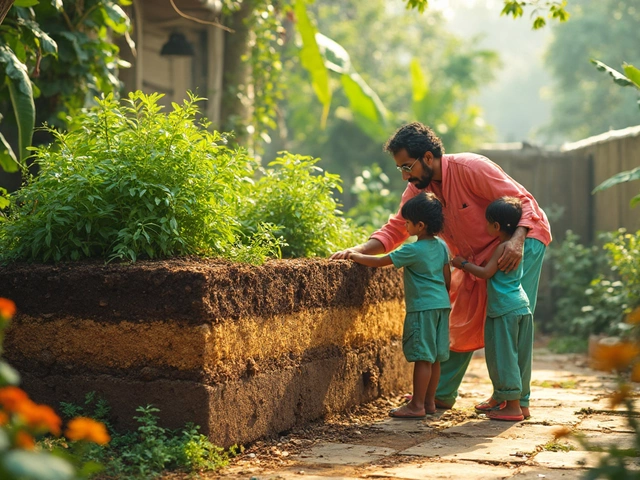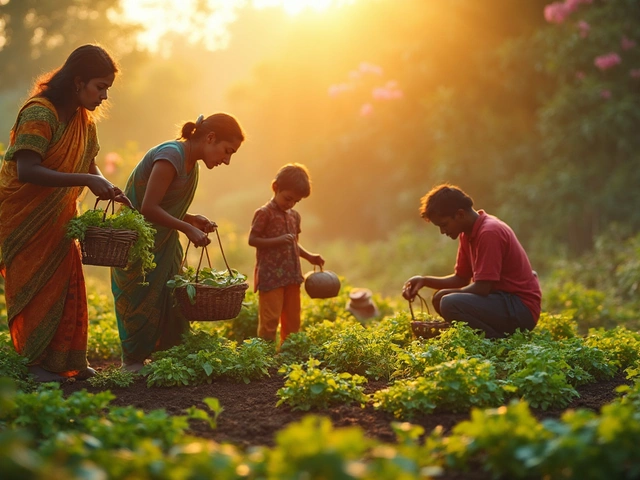Tomatoes are hungry plants—seriously, they will gobble up nutrients way faster than most garden veggies. If you want plump, tasty fruits, you can’t just plant them and forget it. Most folks notice a major difference when they feed their tomatoes on a schedule instead of just tossing fertilizer on when things look sad.
If you’re just starting out, here’s a quick tip: tomatoes need more than just sunlight and water. They’re heavy feeders, sucking up nitrogen, phosphorus, and potassium from the soil all season long. City compost or bagged soil are great, but even those run out of steam before summer’s over.
The real trick is knowing when your plants are hungry—not just blindly following a label. Get this right, and you’ll see deeper green leaves, stronger flowers, and, best of all, more tomatoes you actually want to eat. Stay tuned—I’ll break down exactly how often you should reach for that fertilizer bag, so you spend less time guessing and more time picking ripe, red fruit.
- Why Tomato Plants Need Fertilizer
- Picking the Right Fertilizer for Tomatoes
- Perfect Timing: When to Start Feeding
- How Often to Fertilize During Growth
- Special Fertilizer Tips for Containers and Raised Beds
- What Happens if You Overdo It?
Why Tomato Plants Need Fertilizer
Ever noticed how tomato plants go from tiny sprouts to six-foot beasts in just one summer? That crazy-fast growth drains the soil fast. Tomatoes aren’t light feeders — they’re almost greedy. They need lots of food for deep roots, thick stems, healthy leaves, and, most important, actual tomatoes on the vine.
Even if you’ve got good soil, that first burst of nutrients disappears after just a month or so. As tomatoes mature, their hunger only ramps up. Skip the fertilizer and your tomato plants start to struggle: yellow leaves, weak stems, fewer blossoms, and fruit that never seems to ripen right.
Tomatoes use three main macronutrients:
- Nitrogen – for green growth and quick recovery after pruning or storms
- Phosphorus – helps roots develop and keeps blossoms forming
- Potassium – makes those fruits plump, sweet, and full-flavored
If any of these are missing, you’ll get skinny plants or a measly tomato harvest. Store-bought bagged soil or compost is nice, but it usually doesn’t have enough for a whole tomato season. That’s where smart feeding comes in.
Want the numbers? A study from Cornell University found tomatoes grown with regular fertilization produced up to 40% more fruit than those left to fend for themselves. More food = more tomatoes—it’s that simple. So, if you want garden bragging rights, don’t leave your plants starving for nutrients.
Picking the Right Fertilizer for Tomatoes
This is where most gardeners trip up—they grab the first fertilizer they see, toss it at their tomatoes, and hope for the best. But not all plant food is equal. If you want strong plants and juicy fruit, you’ve got to match the fertilizer to your tomato’s real needs, not just what’s on sale at the garden store.
What should you look for? Tomatoes need a steady supply of nitrogen (for growth), phosphorus (for roots and blooms), and potassium (for overall health and fruit quality). You’ll see these as the N-P-K numbers on every fertilizer bag, like 10-10-10 or 5-10-10. That’s percent nitrogen, percent phosphorus, and percent potassium, in that order.
If you’re starting with decent garden soil, a balanced fertilizer works for early growth. Once you see flowers, switch gears toward a "bloom" or "fruiting" fertilizer with less nitrogen and more phosphorus and potassium—something like 5-10-10 or even 3-4-6. Too much nitrogen after flowering just grows monster leaves and barely any fruit.
- Tomato-specific fertilizers are usually spot-on for these needs, but double-check the label—some are all-purpose and not ideal.
- Organic options like fish emulsion, bone meal, or composted manure release slower, but they’re safer if you’re worried about burning your plants.
- If you’re growing in containers, try a slow-release granular fertilizer mixed into your potting soil at planting time, then supplement with a liquid fertilizer every couple weeks.
Bag labels show a lot of numbers, so here's a quick cheat sheet comparing common fertilizers for tomato growing tips:
| Fertilizer Type | N-P-K Ratio | Best For |
|---|---|---|
| All-purpose (10-10-10) | 10-10-10 | Early growth, leafy stage |
| Bloom/Fruit (5-10-10) | 5-10-10 | After flowering, fruit development |
| Organic (Fish emulsion) | 2-4-1 | All stages, needs more frequent use |
| Compost/Manure | ~1-1-1 | Soil boosting, safe for all stages |
Whatever you choose, don’t double up on doses thinking it’ll speed things along. More isn’t always better—some tomato fertilizer mistakes are hard to fix later in the season. Keep it balanced and timed right, and you’ll help your plants work smarter, not harder.
Perfect Timing: When to Start Feeding
Getting that first round of fertilizer on your tomatoes at the right time is key if you want a bumper harvest. Most people get anxious and toss plant food in too soon, but here's the deal: fertilize a fresh transplant, and it’s like serving steak to a baby. Tomato roots need time to settle in before they can handle a full meal.
The sweet spot to feed your fertilize tomatoes routine is when the plants have been in the ground for about 2–3 weeks. By then, the roots have dug in and are ready for more nutrients than what's leftover in your starter soil or seed-starting mix. A common rookie move is dumping fertilizer right at planting, which can actually burn those little roots—especially if you're using strong chemical types.
Here's the timeline that makes sense for most gardens:
- At transplant – Skip anything but compost or a mild starter fertilizer mixed into the soil. Don’t hit them with the main stuff yet.
- 2–3 weeks after transplant – Time for the first real feeding! Go for a balanced or tomato-focused fertilizer.
- First blossoms – This is when tomato plants start demanding even more food. A second feeding here sets the stage for strong fruit.
Some tomato pros follow their blossoms religiously. A 2023 extension report found that plants given a boost at first flower were 25% more productive than those fed only at planting.
If your season stays cool and wet, you might want to hold off a few extra days before that first feeding. Wet roots take fertilizer harder, and you want to avoid shocking them. Warm, settled plants bounce back faster and really use what you give them.
Remember, starting your tomato plant feeding at just the right time means strong vines, fewer issues, and better flavor. Don’t let impatience wreck your plants’ first big meal—wait until they ask for it, and you’ll see the payoff all summer.

How Often to Fertilize During Growth
Getting on the right schedule for feeding your tomatoes is a total game changer. Most gardeners start by mixing in fertilizer or compost when they plant, but that’s not enough to carry them through the whole season. Tomato plants grow fast and get hungry, especially once fruit sets. If you want continuous big, healthy crops, you’ve got to stick to a routine.
Here’s the basic guideline for feeding tomatoes during their main growth:
- At planting, mix a balanced, slow-release fertilize tomatoes product (or compost) into the soil.
- About 2-3 weeks after planting, give them a boost with a water-soluble or liquid fertilizer.
- From then on, feed every 2-3 weeks throughout flowering and fruiting. Don’t let them run dry before tossing on the next batch—it’s easier to keep up than catch up if your plants get pale and weak.
If your weather gets crazy (lots of rain or heat), your fertilizer can wash out or get used up faster. In really rainy areas, you might actually need to feed as often as every 10-14 days, but in steady, average weather, every 2-3 weeks is just right for most folks.
| Growth Stage | Fertilizer Timing |
|---|---|
| At Planting | Mix in slow-release or compost |
| 2-3 Weeks After Planting | Liquid or granular fertilizer |
| Flowering/Fruiting | Every 2-3 weeks |
| Heavy Rainy Periods | Every 10-14 days |
Watch for clues from your plants, too. Yellow leaves, weak stems, and slow growth all mean it’s time to feed. But don’t go overboard—too much, and you’ll get lots of leaves but weak fruit. Stick to the regular schedule, and your tomato plant feeding will pay off with stronger, tastier crops, even in tough seasons.
Special Fertilizer Tips for Containers and Raised Beds
If you’re growing tomatoes in containers or raised beds, listen up: you have less room for error when it comes to feeding. These setups dry out faster, leach nutrients quicker, and leave your plants hungry way sooner than in-ground gardens. That means your approach to fertilize tomatoes has to be dialed in.
Tomato plant feeding in containers is almost like looking after a pet—it needs regular attention. Start with a slow-release fertilizer mixed into your potting mix, but don’t stop there. Container tomatoes burn through nutrients fast, so add a liquid or water-soluble fertilizer every 2-3 weeks once they start flowering. If leaves look pale or growth seems stopped, increase the feeding to every 10 days. Quick tip: go easy with the dose; half-strength is safer than overfeeding.
With raised beds, things get a bit easier but still need attention. The soil drains better than containers, but nutrients still wash away faster than in the ground. Work in a good handful of compost and balanced granular fertilizer before planting. After the first month, side-dress your tomatoes every 3-4 weeks with organic fertilizer (think fish bone meal or worm castings) to keep feeding steady. Mulching helps lock in both water and nutrients, so toss on a 2-inch layer after your first feed.
Check out how container and raised bed tomato feeding needs stack up against regular garden rows:
| Setup | Fertilizer Frequency | Best Fertilizer Type |
|---|---|---|
| In-Ground | Every 4-6 weeks | Granular, organic, or slow-release |
| Raised Beds | Every 3-4 weeks | Granular, compost, side-dressing |
| Containers | Every 2-3 weeks (more if hot or plants look needy) | Liquid, water-soluble, or slow-release |
Don’t skip regular watering, since dry soil can make fertilizer burn the roots. If you see yellow leaves fast after feeding, flush the soil with lots of water and cut back on strength next time. Keeping a simple log of when and how much you feed seriously helps—container tomatoes especially make you pay for missed meals.
What Happens if You Overdo It?
Dumping too much fertilizer on your tomatoes can actually ruin your whole crop. It’s tempting to think more plant food means more tomatoes, but that’s not how this works. Piling on extra fertilize tomatoes products can backfire fast.
One of the most obvious signs is big, bushy green plants with hardly any fruit. They look healthy from a distance, but up close, you’ll notice lots of leaves, barely any flowers, and even fewer tomatoes. That’s what too much nitrogen does—it turns your tomato patch into a leafy jungle instead of a fruit factory.
Root burn is another big issue. Over-fertilizing can leave white crust on the soil, which actually scorches the roots. Plants then struggle to take up water, and the leaves might wilt for no clear reason, especially right after feeding. Yellow edges on leaves or crispy, brown tips? Classic signs of fertilizer overload.
Maybe even worse, too much fertilizer can leach out and mess up local water sources. Synthetic fertilizers that go overboard rinse right through sandy or loose garden soils, especially after heavy rain. That’s just wasting money and causing pollution, and local communities are cracking down on this now more than ever.
If you think you might have overfed your tomatoes, here’s what you can do:
- Water the soil deeply—flush out the excess nutrients with several good soakings over a couple of days.
- Skip your next scheduled feeding, and don’t add any more fertilizer until you see plants bounce back.
- Check the fertilizer package—make sure you’re using the right type and strength for tomatoes, not just any old plant food.
- Use mulch to slow down runoff and keep roots protected while plants recover.
A 2023 study actually showed that tomato plants given double their recommended fertilizer made 33% fewer fruits than plants on the regular schedule. Here’s how that can look on paper:
| Fertilizer Schedule | Average Fruits per Plant |
|---|---|
| Normal (as directed) | 65 |
| Too Much (2x) | 44 |
So next time you reach for that extra scoop, remember: It's not just about how often you feed, but how much. Follow the directions, watch your plants, and they’ll give you plenty back.





